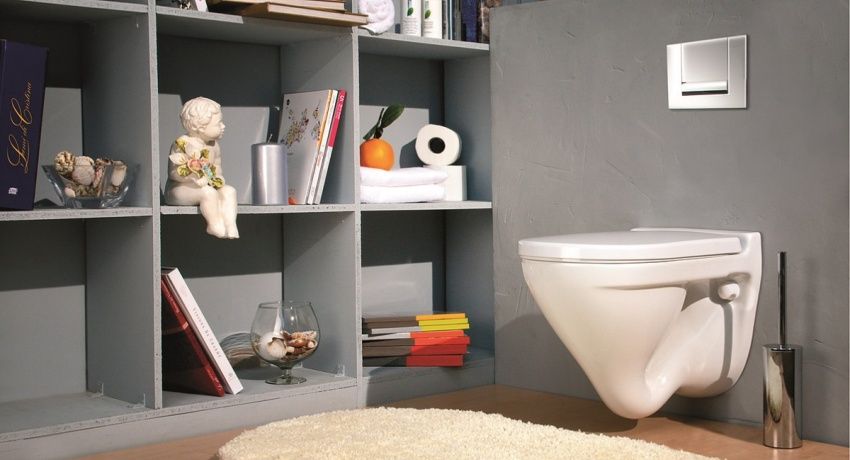When planning to carry out repairs in the house, you should think not only about the design of a stylish and modern interior, but also about how to ensure comfortable living conditions. One of these ways – laying a warm floor under the tile. Consider how to carry out all the necessary work as simple as possible and what to look for in the process of self-installation.
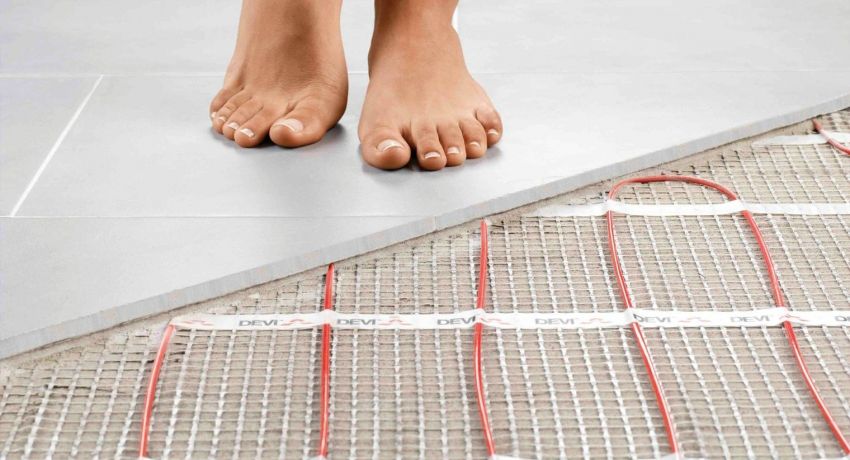
Advantages of installing under floor heating under tiles
Heated floor has a lot of positive characteristics and subject to all recommendations can have a very positive effect on many aspects, increasing the level of comfort of all living in the house.

First of all, this is due to the uniform distribution of heat in the room. Due to the fact that the bulk of the warm air is located below, the overall temperature in the room will be as favorable as possible, because, as you know, warm air is easier and tends to rise up.
Interesting! From a medical point of view, air distribution in such a way that the feet are warm and the head cool, is considered the best option.
In the case of using such heating devices as batteries and converters, the air moves more actively in the room, due to which the number of drafts increases, and, accordingly, the amount of dust raised. Heated floors have different principles that also have a positive effect on health.
As for ceramic tiles, as a finishing material laid on top of such a system, this is an excellent solution for several reasons:
- high level of thermal conductivity;
- long service life;
- resistance to temperature extremes;
- ability to withstand severe mechanical stress;
- resistance to water and steam.
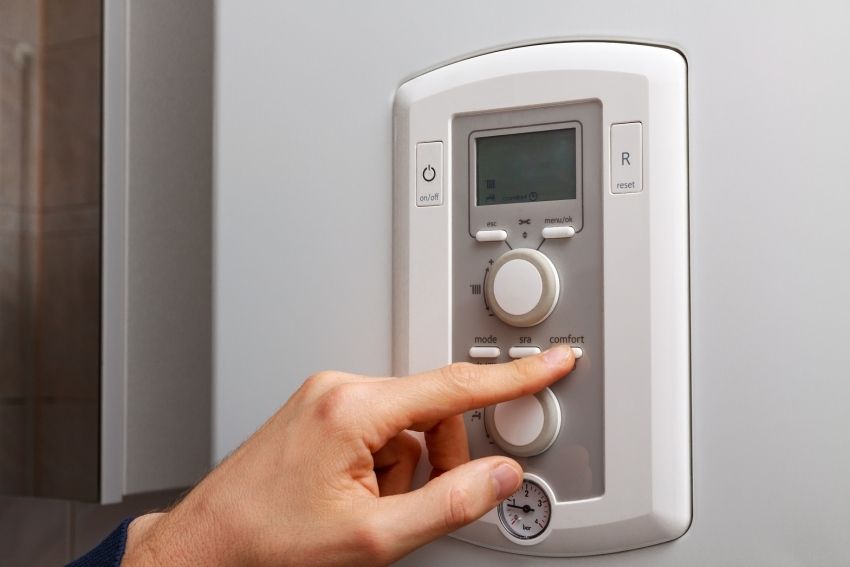
The high thermal conductivity of the tile makes it ideal for installing a floor heating system. Moreover, in this case, any kind of system can be used: electric or water. But in order to choose the most suitable option, each owner must answer a few questions in advance:
- is the underfloor heating system the main source of heating or will it be used only as an additional one;
- whether a concrete screed is provided and, if so, how thick it is;
- Autonomous or central heating system is provided in the house.
By answering these questions and considering the characteristics and advantages of each option, you can make and carry out the most efficient installation of a heated floor under the tile. Consider all the options available today.

Water heated floor – the most widespread option to date, which is widely used for the arrangement of bathrooms, kitchens and corridors. In this case, a special system consisting of water pipes is placed directly in the floor screed.
In this case, be sure to carry out the laying of several layers, each of which has its own value and role in this design:
- A layer of heat-insulating material is laid on top of the base, which does not allow the system to use heat in vain, heating overlaps;
- they put a reinforcing mesh on top, which should give strength to the base;
- then the pipe system is located, which is directly responsible for the circulation of warm water;
- another layer of screed (cement-sand or concrete) is designed to protect the structure from stress;
- Finally, the adhesive composition is applied, on which the ceramic tile is fixed.
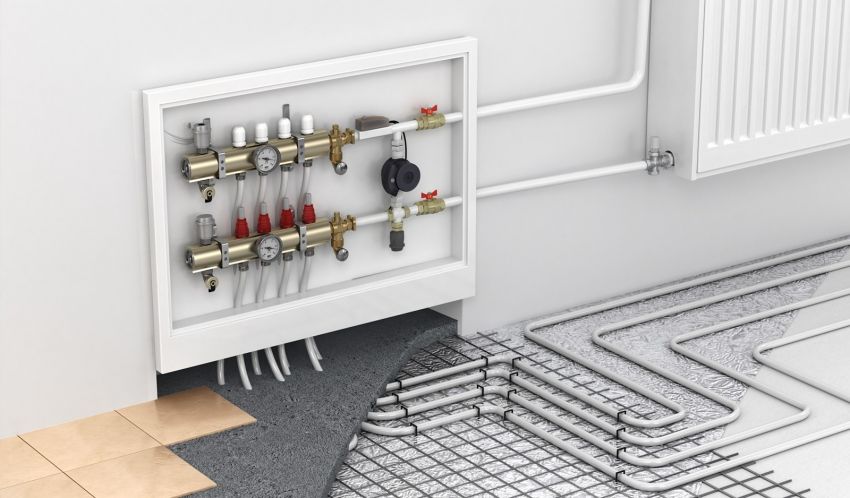
If the owners decided to make such warm floors under the tile with their own hands, then in the process of work it is important to observe some nuances. For example, the gap between the metal-plastic pipes of the system should be from 10 to 30 cm. In this case, the fixing with the help of plastic clamps must be made.
Helpful advice! In order to improve the strength and quality of the water heating system, in those places where the expansion joint is located on the pipes, it is recommended to wear a corrugation.
During the installation of the system itself it is necessary to avoid the appearance of joints, therefore the inlet and outlet of the pipe must be located in the collector. In addition, before you start pouring the top layer of the screed, it is worth installing a damper tape around the perimeter of the room. It serves to compensate for those expansions that will occur as a result of expansion processes associated with changes in temperature.
After the installation of the pipe system is completed, it is imperative that an inspection be carried out, and only after that it is possible to proceed to the filling of the rough surface. It is important that the thickness of the screed layer is at least 30 mm.

If all the calculations, as well as the procedure for laying a warm water floor under the tile were made correctly, this solution will save up to 10% of the thermal resources required for monthly heating of the room.
Earlier, only wealthy people could afford to buy electric warm under the tile. But today, this technology has become available for almost everyone, especially given the fact that its installation can save up to 35% of the resources spent. Such a high rate became available, first of all, due to the possibility of installing a thermostat.
As an example, you can consider the option of arranging a heated floor in the bathroom using a heating mat. With an area of 0.65 m ?, it consumes no more electricity than a conventional light bulb. At the same time a half meter mat will require a little more (like 3 bulbs). If compared with household appliances, the mats are bigger, then the three-meter one is commensurate with the computer, and the six-meter one with the refrigerator.
Important! Electric power consumption in this case directly depends on how fast the surface cools. In other words, high-quality insulation can significantly reduce costs.

The price of a warm electric floor under the tile depends on how high-quality and reliable the option has been chosen, as well as on how many conductive wires are located in the heating cable. There are two options: single-core and two-core. Moreover, the first option can be used only in non-residential premises, since it emits a large number of electromagnetic waves. But in the second case, the two conductive elements are able to compensate for the fields of each other.
On the modern market there are several different technologies that allow you to effectively heat the floor. Depending on the element used for heating, the following types are distinguished:
- Cable
- Infrared (film).
- Heating mats.
Each of these methods is safe enough to be used in a residential area. In addition, these modern technologies have a rather long operational life (up to 20 years). All options are designed to reduce energy consumption, and can be used both as a primary and as an additional source of heat. So even in the case of installing a heated floor in the bath under the tile, the savings will be immediately noticeable.
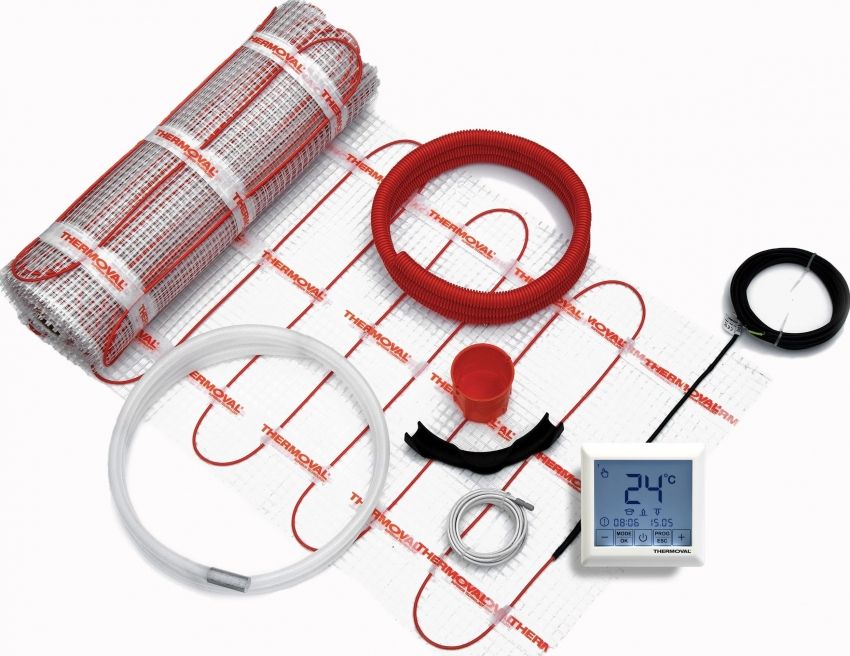
This is one of the newest methods, which has become widespread recently. But every day its popularity increases, which is associated with ease of installation and excellent technical characteristics. In this case, a special cable system is used in the form of a heating mat, which can be incorporated in the process of installing a new floor or reconstructing the old one.
The technology involves the use of a special two-core shielded cable, whose thickness is 2.5 mm. And the installation procedure is as simple as possible: using a cement-sand screed, the heating element is poured on the surface of the base.
In this case, a special electrical cable is used as a heating element, which is laid with a snake on the surface of the base. At the same time, they must observe a certain step and perform fixation with the aid of the petals of the mounting tape. All this, including a corrugated tube and a thermal sensor, is poured with a concrete tie, which is 3-5 cm thick.

The main advantage of this method is the ability to mount the system not only on the floor, but also on the walls, and even on the ceiling. The heating element of this type is made by a special technology that allows you to make a warm floor without a screed.
Underfloor heating under the tile provides for a special coating that eliminates the need for pouring the screed and makes the installation process easier. In this case, not only tile, but also any other building material, which can be found on sale today, can be used as a finishing flooring.
As mentioned earlier, the selection of the most appropriate option should be based on the premise data that is initially available. Each of the considered methods has its advantages and can be used for home improvement. For example, water heating system can be connected to the system of autonomous and centralized heating. In addition, this option is most beneficial in terms of financial costs.

Low costs and maintenance of the water system. However, this method is not always the best. For example, it is better to refuse such a solution in old houses, where the floor slabs are not designed for serious loads, which may result in the installation of such a system.
Electric heating is easier to install and also has higher energy efficiency. The surface of the coating heats up faster, and with proper insulation, it can keep the accumulated heat for a long time.
Helpful advice! You should not turn on the floor heating until all the compounds (glue and grout) are completely dry. The same applies to the concrete screed, the drying period which can be from two weeks to a month.
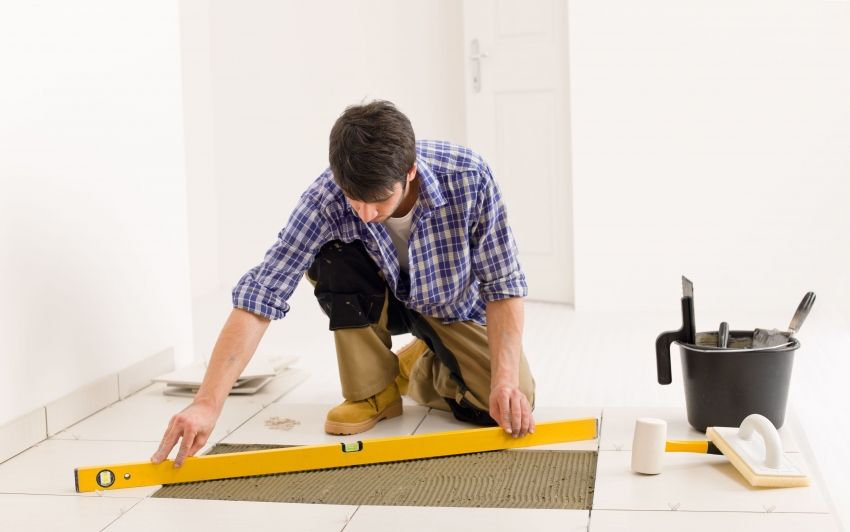
An excellent guideline for installing underfloor heating is a photo instruction that will allow you to take a closer look at each stage of the work and clearly demonstrate all the nuances. But still, the most complete information about the process can be obtained by reading the relevant video tutorial.
